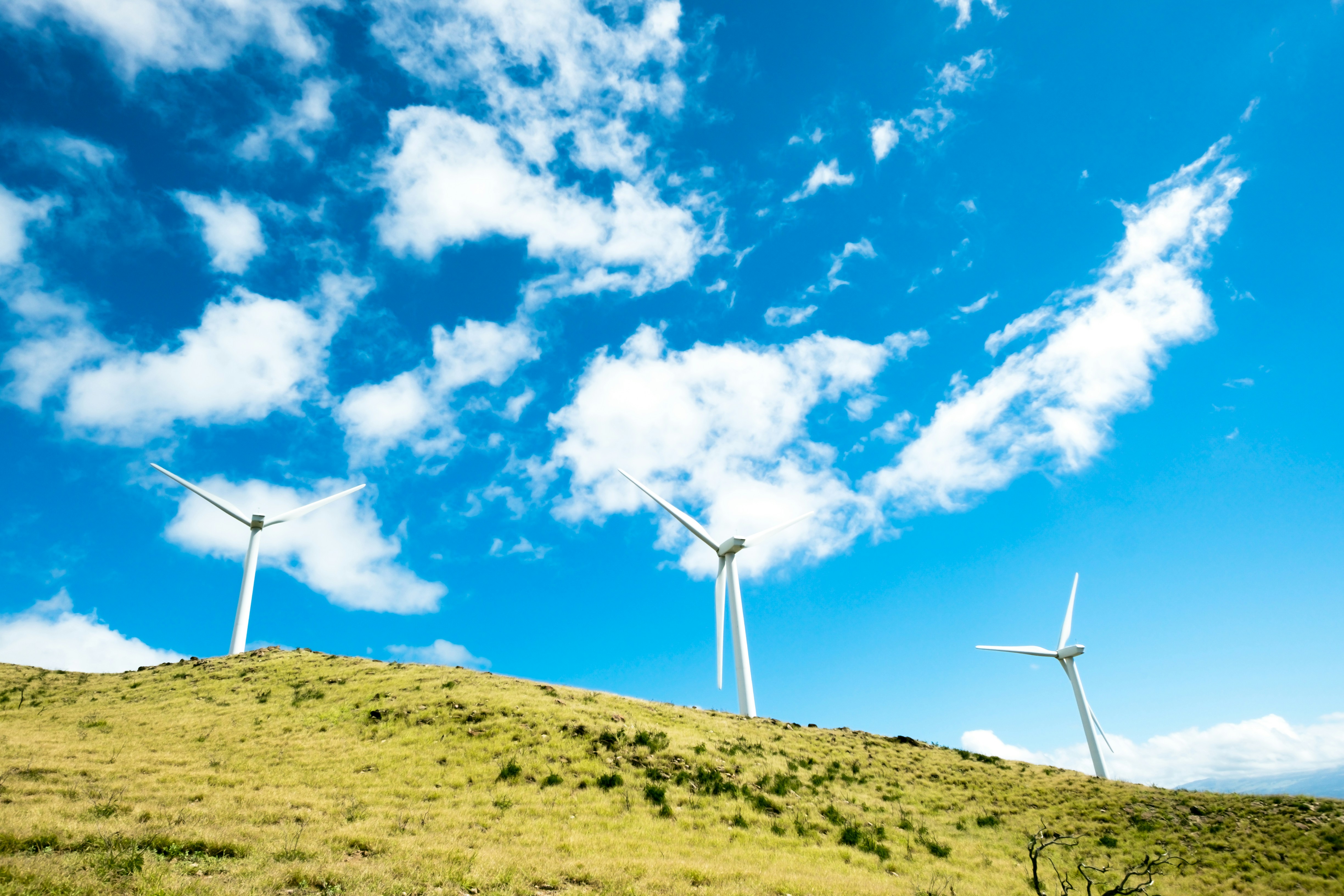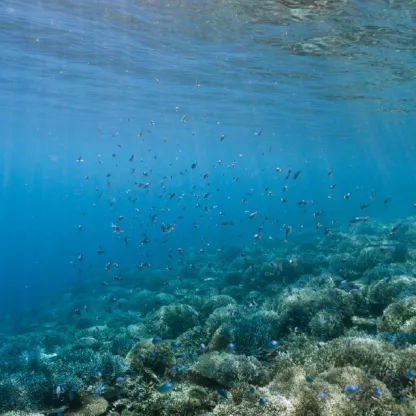Renewables generated a record 50.4% of the UK’s electricity in 2024, led by wind and solar. With coal phased out and battery storage expanding, the UK is set for continued clean energy growth.

Sustainability update August 2025
Article last updated 19 September 2025.
Government report confirms record use of renewables for domestic electricity generation in 2024
Energy statistics published by the Department for Energy Security and Net Zero (DESNZ) show that renewable technologies generated 50.4% of the UK’s electricity in 2024, a 4% increase on the previous year and a new overall record. Fossil fuel generation fell to just 31.8% in the same period, marked by favourable weather conditions and the closure of the country’s last coal-fired power plant, Ratcliffe-on-Soar in Nottinghamshire.
Wind was the UK’s predominant clean power source in 2024, with onshore and offshore facilities accounting for 58% of renewables-generated electricity. Production spikes were also observed in the solar and nuclear energy sectors, which together accounted for almost 20% of electricity generation in 2024. Oil production was down 8.8% while gas production fell by 10% fall – domestic production of both fossil fuels is now 75% below peak rates recorded in 1999 and over 30% below pre-pandemic levels.
There were signs that the increase in domestic clean energy generation observed in 2024 could continue through 2025 and beyond. Solar power generation in August was around 30% higher than in August 2024 – enough to power more than 5 million homes for a year – and for a 30-minute period on 8 July, solar output was a record 14GW. The rapid development of solar infrastructure and prolonged good weather across the UK has resulted in record capacity, further convincing the government to upscale its investment in solar technologies to 2030. Elsewhere, the UK’s largest battery energy storage system (BESS) began delivering electricity to the grid supporting London and the Southeast. Thurrock Storage was connected to the National Grid’s substation at Tilbury, providing 300MW of flexible storage to counter fluctuations in clean energy supply.
Despite the rollback of clean energy investment in the US and ongoing uncertainty over the scale and impact of threatened trade tariffs, global investment in renewable energy projects reached a record $386 billion during the first half of 2025, driven largely by increases in small-scale solar and offshore wind development. Mainland China – accounting for 44% of global clean energy investments – saw a major spike in small-scale solar investment as developers sought to complete projects prior to planned regulatory changes exposing renewables to volatile energy prices. Europe experienced a 63% rise in investment as capital earmarked for offshore wind projects in the US sought opportunities elsewhere. Emerging markets largely backed up the rapid growth in investments they recorded in 2024 with Latin America and Southeast Asia both increasing their regional share. Many of the headwinds impacting the renewables sector in recent years have now dissipated, with US offshore wind an outlier. In the longer term, the sector is expected to continue to grow significantly and take an increasing share of new electricity demand, led by solar, and supported by increased installation of battery storage.
Geneva talks fail to reach consensus on the control of global plastic pollution
The sixth meeting of the Intergovernmental Negotiating Committee on plastic pollution (INC5.2) ended without agreement on a legally binding treaty for controlling plastic waste in terrestrial and marine environments. With more than 460 million metric tonnes of plastic produced annually, global waste levels are expected to reach 1.7 billion metric tonnes by 2060 – the projected economic cost of plastic pollution between 2016 and 2040 could exceed $280 trillion.
In 2022, the UN Environment Assembly issued a mandate to develop a comprehensive approach addressing the full lifecycle of plastics, from design and production to consumption and waste management. However, delegates remain divided on the broader scope of the mandate with some arguing for stricter limits on global production and others – mostly oil-producing states – pushing for a greater focus on recovery and recycling. Producers insist that plastics are an economic necessity fundamental for modern life, while environmentalists contend that upscaling recovery and recycling services alone will not be sufficient to counter the rate of production, consumption and waste. Government subsidies have also complicated the negotiation process. Research by environmental consultancy Eunomia estimated that governments provided $80 billion of financial assistance to global polymer producers in 2024.
Plastic chemicals and compounds are traceable in many environmental ecosystems, and the evidence of plastic toxins in food chains and clean water services is rapidly increasing the risk to global public health. A recent report by The Lancet assessed the relationship between plastic production and human wellbeing, identifying an “under-recognised danger to human and planetary health”. It concluded that plastics contribute to disease and death for people of all age groups and estimated an annual cost of $1.5 trillion in global health-related economic losses. The report also found that almost half the world’s plastic waste was chronically mismanaged, with widespread dumping and burning accelerating the release of harmful toxins.
Though a date for future negotiations wasn’t set, most countries remain committed to a global deal. Around 100 countries, including the UK and EU member states, used the Geneva talks to reiterate their support for the broader treaty mandate. Some participating nations indicated they would support the implementation of a voting system to encourage progress on points of contention. At the close of the Geneva meeting, UN Environment Programme executive director Inger Andersen observed that: “We did not get where we wanted, but people want a deal. This work will not stop, because plastic pollution will not stop”.
Climate disclosures developing and expanding despite rollback on net zero ambition
Driven largely by shifting attitudes and policies in the US, the year has seen the gradual dissolution of key net zero initiatives. In January, the UN-backed Net Zero Asset Managers initiative (NZAM) suspended its activities pending a strategic review. In April, the Net Zero Banking Alliance (NZBA) softened its stance by voting to drop the requirement for banks to set climate targets aligned with limiting global warming to 1.5C – after an exodus of institutions responding to the broader ESG backlash, the Alliance initiated a vote among its remaining members in August to determine whether it should continue as a membership organisation or transitions to a support network for banks measuring and reducing financed emissions.
Despite these setbacks, analysis of the global sustainable disclosure landscape by the Risk Centre team of the United Nations Environment Programme Finance Initiative (UNEP FI) demonstrated that climate disclosures were continuing to develop and expand under voluntary and mandatory frameworks. The analysis included data from the International Financial Reporting Standards Foundation (IFRS) which showed that 49 worldwide jurisdictions had either introduced or intended to introduce sustainability-related disclosure requirements into their regulatory frameworks in 2025. Of these, 47 had adopted or planned to adopt global disclosure standards established by the International Sustainability Standards Board (ISSB). Understanding regional resources and requirements helps companies track jurisdictional expectations and align their sustainability disclosures to incorporate or be highly interoperable with recognised global standards.
Highlighting a growing trend of companies building climate action into commercial strategies, the Science Based Targets initiative (SBTi) revealed that more businesses were setting and maintaining targets than abandoning them. The SBTi’s new trend tracker showed that the number of companies setting near-term net zero targets had increased by 97% between the end of 2023 and Q2 2025 – in the same period, the number of companies setting long-term targets surged by 227%. The share of global market capitalisation under science-based targets increased to almost 41% at the end of 2024 which the SBTi said reflected “consistent corporate engagement”. Almost 9,000 companies have emissions targets validated by the SBTi – the initiative believes that incorporating a science-based approach helps to futureproof competitiveness, allowing companies to capitalise on low-carbon opportunities.




